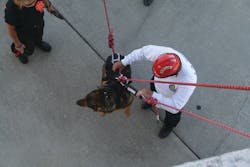TECHNICAL RESCUE: Louisiana USAR Task Force Trains in Canine-Lift Techniques
By its very name, an urban search and rescue (USAR) task force must be able to search. The three standard search techniques are physical, technical and canine. All three have advantages and disadvantages that must be considered when a task force is deployed.
Canines are especially useful when a large area must be covered. A search dog can be a reliable indicator that a live person or human remains are present. On the other hand, dogs are very much affected by weather, wind, ambient temperature and other conditions. The scent flow through the spaces and crevices of a rubble pile can give false readings as to the location of a victim.
Louisiana Task Force 1 (LA TF-1), a state USAR team, has a strong canine search element. The task force has a memorandum of understanding with Louisiana Search and Rescue (LASAR), an organization of volunteers (see “Teamwork in Action: Training the New Orleans Fire Department Canine Search Team” in the June 2011 issue of Firehouse®). LASAR has an excellent training program. It takes approximately two years to prepare a dog and its handler for outside certification, and this is combined with a weekly, organized continuing education program to keep the teams finely tuned. LASAR has both live-person and human-remains search capabilities and deploys teams all over the country on a regular basis.
To maintain its USAR skills, LASAR trains with LA TF-1 throughout the year. In October 2011, inspired by training LASAR members had done in Alabama and by an article in a British technical rescue magazine, LA TF-1 decided to conduct a practical drill lifting canines using a rope system. Bill Schneider from Kansas TF-1 had given LASAR a canine harness as a gift, and his generosity moved me to buy the team another. Here was a chance to try them out. Several of our team members wondered when we would actually use such an application. I had to agree that there are not many situations where we would use the technique, but it always helps to have as many tools in the tool kit as possible to be ready for any eventuality. We decided to simulate lifting the dogs in a structure with limited access.
We decided to use the training tower at the New Orleans Fire Department’s Municipal Training Academy for the lift. Our plan was to lift the dogs to a landing on the second floor initially to test the system and the canines, and then re-rig and haul the dogs up through a window on the fifth floor. We built our 3:1 Z-rig haul system on the ground and sent a team member with a directional pulley and one end of the main line to establish a high point on the tower one floor above the target floor. I believe it is not only safer to build a haul system on the ground, but more efficient in that there is more room to “stretch” the system, resulting in fewer resets, which is important when dogs are suspended in harness at height. A top safety line was established on the target floor and a tag line was set up to keep the dogs from contacting the side of the structure during the lift.
The practice lift went well. The dogs accepted the harnesses well and were encouraged by their handlers and other team members as they were attached to the rope system. As the lift began, the handlers moved to the second-floor landing to be there when the dogs arrived to help calm them during the difficult transition back to the ground. All of the canines behaved magnificently, which did not surprise those of us who had worked with them before and had become accustomed to their discipline, intelligence and even dispositions.
Once all the dogs had participated in the practice lift, we re-rigged our rope system for a 50-foot lift. The first lift brought the dogs over a parapet on an open floor, so for this lift we wanted to bring them through a window. The transition through the window would be difficult, so, just as with the first lift, we wanted to establish a high point for the main line one floor above the target floor. We did this for safety reasons as we were making our first attempt at this technique.
The second lift went as well as the first. The canines were just as calm going up 50 feet as they were going 10. We continued having the handlers stay with the dogs at the beginning and end of the lift, but there was a relatively long period when the dogs were hanging in the harness unsupervised and they stood this quite well. We only had to reset the haul system once and the average suspension time for the dogs was about 40 seconds. The dogs came through the window easily with the lift commander coordinating the main and tag line handlers to position the canines correctly. We used one LA TF-1 member and the canine’s handler to bring him or her through the window.
The drill was extremely successful. Our rescue and search personnel got a good rope rescue refresher, and our canine folks got to work with a brand new technique. Team members from several disciplines coordinated operations. We added some new tools to the tool kit and sharpened some old ones. As a USAR task force must be ready to perform many tasks, working with canines and rope is one that sooner or later will come our way.
